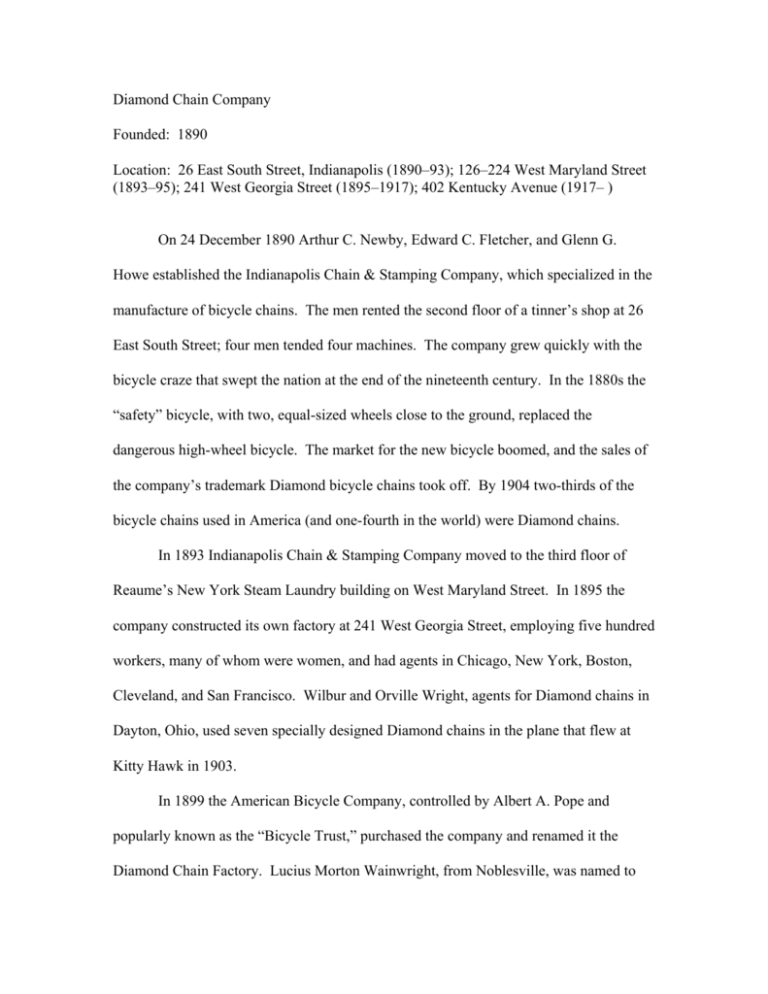Diamond Chain Company Founded: 1890 Location: 26 East South
advertisement

Diamond Chain Company Founded: 1890 Location: 26 East South Street, Indianapolis (1890–93); 126–224 West Maryland Street (1893–95); 241 West Georgia Street (1895–1917); 402 Kentucky Avenue (1917– ) On 24 December 1890 Arthur C. Newby, Edward C. Fletcher, and Glenn G. Howe established the Indianapolis Chain & Stamping Company, which specialized in the manufacture of bicycle chains. The men rented the second floor of a tinner’s shop at 26 East South Street; four men tended four machines. The company grew quickly with the bicycle craze that swept the nation at the end of the nineteenth century. In the 1880s the “safety” bicycle, with two, equal-sized wheels close to the ground, replaced the dangerous high-wheel bicycle. The market for the new bicycle boomed, and the sales of the company’s trademark Diamond bicycle chains took off. By 1904 two-thirds of the bicycle chains used in America (and one-fourth in the world) were Diamond chains. In 1893 Indianapolis Chain & Stamping Company moved to the third floor of Reaume’s New York Steam Laundry building on West Maryland Street. In 1895 the company constructed its own factory at 241 West Georgia Street, employing five hundred workers, many of whom were women, and had agents in Chicago, New York, Boston, Cleveland, and San Francisco. Wilbur and Orville Wright, agents for Diamond chains in Dayton, Ohio, used seven specially designed Diamond chains in the plane that flew at Kitty Hawk in 1903. In 1899 the American Bicycle Company, controlled by Albert A. Pope and popularly known as the “Bicycle Trust,” purchased the company and renamed it the Diamond Chain Factory. Lucius Morton Wainwright, from Noblesville, was named to run the company. Wainwright was an avid bicyclist who had developed a one-piece bicycle crankshaft and had launched an unsuccessful bicycle company before going to work for Pope. Wainwright expanded the company’s production beyond bicycle chains to include a variety of pin, roller, and block chains for use in both industrial machines and automobiles. Indeed, by 1913 the bicycle chain line was a minor element of the company’s total production, and by the 1920s foreign competition, utilizing cheap labor, was squeezing the Diamond Chain Company out of the bicycle chain market. Pope sold Diamond Chain to a partnership controlled by Wainwright in 1904 for $400,000. Diamond Chain & Manufacturing Company was incorporated in 1905. In order to preserve part of the bicycle chain market, Wainwright had had his designers develop a low-cost but durable chain. This chain, the only one produced outside Germany, France, and England, became invaluable during World War I. Diamond Chain became the principal source for bicycle chains for the United States and overseas during the war, employing 1,100 people in its factory. In 1917 a new factory was constructed at 402 Kentucky Avenue, a site previously occupied by the Greenlawn Cemetery, and there have been six major additions to this facility. Under Wainwright’s leadership the management of Diamond Chain and Manufacturing was a model of corporate progressivism. During World War I the company sponsored a cooperative grocery store. In addition, the company sponsored a factory school operated jointly with the Indianapolis school system. Employees could study industrial topics, factory processes, general academic fields, first aid, or domestic sciences. (Academic instruction might well reinforce factory discipline, however; decimals were taught with the aid of time clocks.) By 1925 the employees had access to a group life insurance program and a credit union. In 1943 the United Steelworkers of America organized Local 1697 at Diamond Chain. The diversification of the company’s product line to include multiple chains and timing devices for trucks, cars, and motorcycles helped it weather the Great Depression. After Lucius Wainwright’s death in 1931, his son, Guy Wainwright, became president of the company. In 1946 the name of the company was changed to Diamond Chain Company, and in 1950 it was acquired by American Steel Foundries (later Amsted Industries). In the 1960s Diamond Chain Company was producing chains used in over 130 different industries and purchased interests in overseas roller chain manufacturing plants. By the 1980s the company was importing lower cost chains abroad that it marketed in the United States. In 1993 Diamond Chain had 600 employees.






